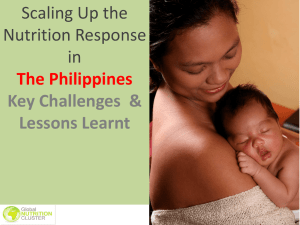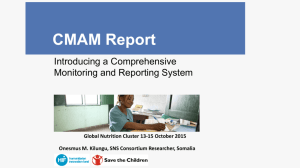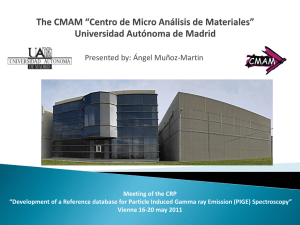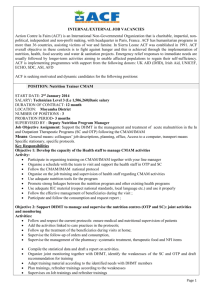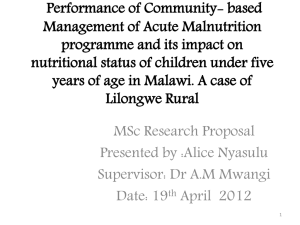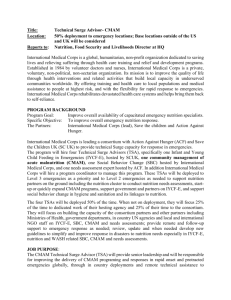Scaling up Community based Management of Acute Malnutrition
advertisement
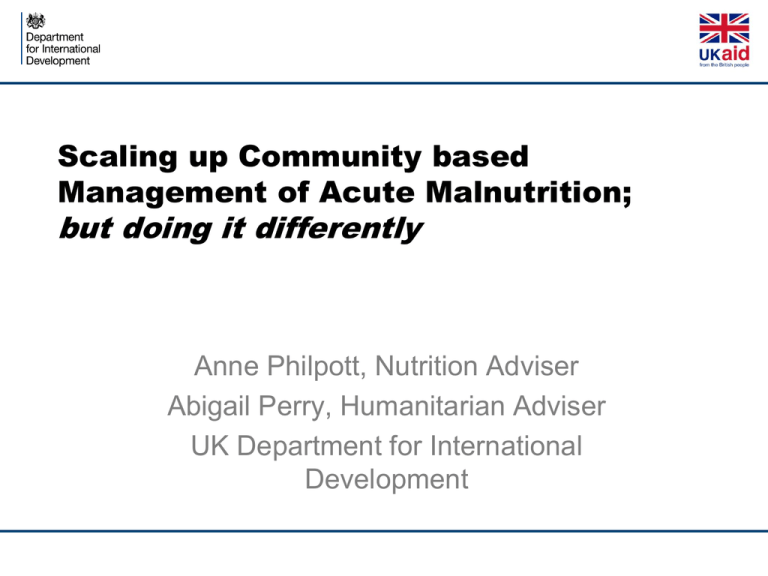
Scaling up Community based Management of Acute Malnutrition; but doing it differently Anne Philpott, Nutrition Adviser Abigail Perry, Humanitarian Adviser UK Department for International Development Introduction • CMAM has been a common element of our humanitarian programmes since the CTC model was first established • In recent years, DFID has been expanding nutrition investments: – 2011: Nutrition Position Paper published, outlining our goal to reach 20 million pregnant women and children under five with nutrition relevant services by 2015 – June 2013: co-hosted a global summit ‘Nutrition for Growth’ that galvanised additional £2.7 billion of financial commitments for nutrition and published a compact endorsed by more than 100 stakeholders committed to reduce stunting. DFID committed to triple its nutrition funding by 2020 • Increasingly providing longer-term funding for CMAM through national governments, including budget support and sector reform programmes • Today we will highlight some examples and our lessons from ‘doing CMAM differently’ Malawi India Ethiopia Kenya Malawi –Health Ministry and UNICEF • DFID Malawi works with MoH to treat SAM – covering 85% of the health facilities. However a period of food insecurity meant that it was strengthened in 16 food insecure districts with DFID’s funding through UNICEF. • Severe acute malnutrition treatment in hospital with Nutrition Rehabilitation Centres with therapeutic milk – and treatment at health facility, with therapeutic food – RUTF. • Complemented with growth monitoring and promotion, Vitamin A supplementation, immunization, treatment of common childhood diseases for children under 5 years of old. • RUTF local production with Valid International. India –Health, Nutrition Depts and NGOs • India has 40 % of global burden of SAM and no treatment in community • Very small scale provision under ‘emergency’ floods in Bihar • Since 2010 Govts of Odisha, Madhya Pradesh with DFID, Valid and Right to Food NGOS are moving towards piloting CMAM – – Testing small scale women’s groups production – Comparing community with hospital treatment – State Agri companies piloting production in Madhya Pradesh • Ministry of Health issuing CMAM guidelines imminently • Ministry of Women and Child Development in MP and Odisha testing community approaches to SAM • Plans to develop a public sector product Ethiopia – with Health Dept & UNICEF In the new £36.3 million DFID funding programme support to make CMAM and integral part of Ethiopian National Nutrition Program. – ensuring access to quality CMAM services and securing procurement of therapeutic food for CMAM through multi-year and predictable funding for the program. – CMAM services will be expanded and integrated as routine service in every health post and at least one Stabilisation Centre (SC) per woreda (district) – Aim is to integrate CMAM into the public health system of Ethiopia – Regional Health Bureaus strengthened to coordinate with NGOs, forecast and manage supplies of therapeutic foods, and monitor performance. – Health Extension Workers’ supervisors will be trained to undertake accurate assessment of the overall CMAM service quality using a score card system. – Government supply chain and logistics management will be strengthened and CMAM supply chain management will be progressively transitioned into the government’s Pharmaceutical Fund and Supplies Agency (PFSA) of the MOH. UNICEF has undertaken supply chain bottleneck analysis and RUTF leakage assessment – CMAM rollout in Ethiopia has enabled access to trend data on admissions of severely malnourished children to health facilities over the past few years – easy to see the progress or deterioration of a given nutrition situation. Kenya ASALs – Emerging from humanitarian crisis • £16.8 million between 2012 and 2015 to support scale up of HiNi* in arid and semi-arid lands (ASALs) through health system • Funding through NGOs to support service delivery and capacity strengthening • Funding through UNICEF to support system strengthening and county-level planning for nutrition • Focus on flexibility in context of fluctuating GAM %: – Supply chain management / forecasting – HR surge capacity – Early warning / triggers • Key challenges: gaps in broader health system, balancing focus on nutrition, underlying causes, availability of other donor funding *High impact Nutrition interventions Conclusion • Different contexts means there is currently no one-size-fits-all approach to funding CMAM • Key to work within existing (or future) policies and systems to ensure CMAM can be sustained • Critical period for lesson learning - for DFID and the broader nutrition community: – Implementing at scale – Building commitment and developing policy / practice – Positioning nutrition within health systems – Bridging development and humanitarian response through flexible approaches
